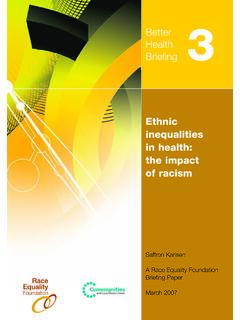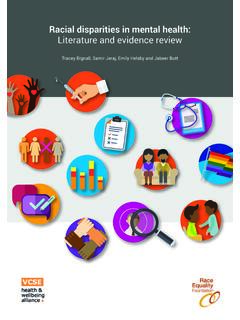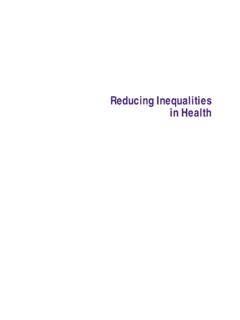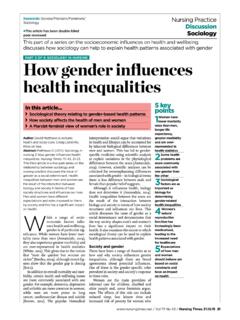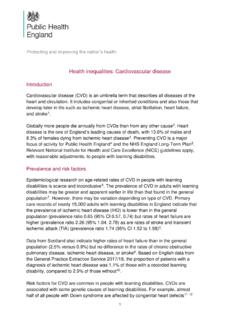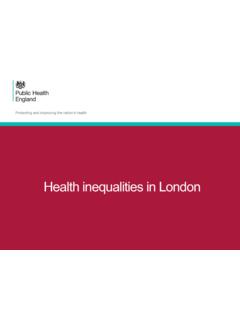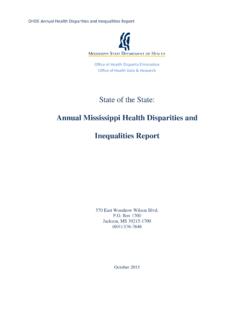Transcription of Tackling health inequalities for minority ethnic groups ...
1 Tackling healthinequalities forminority ethnicgroups:challenges andopportunities Gurch Randhawa A Race Equality FoundationBriefing PaperJuly 2007 BetterHealthBriefing6 4321 Better health Briefing 6 Tackling health inequalities for minority ethnic groups : challenges and opportunitiesIntroductionThe Government s Cross Cutting Reviewof health inequalities , published earlier this decade, reminded us thatnot only do health gaps still exist in the UK but, in some cases, they are growing ever wider:There are wide geographical variations in health status, reflecting the multiple problems of materialdisadvantage facing some communities.
2 These differences begin at conception and continue throughoutlife. Babies born to poorer families are more likely to be born prematurely, are at greater risk of infantmortality and have a greater likelihood of poverty, impaired development and chronic disease in later sets up an inter-generational cycle of health inequalities . (DH, 2002b, p. 1)This statement reflects the shift in focus of policy during the last twenty years in which there has been agrowing interest in the health of different communities in the UK. Throughout this period, the provision of health care for minority ethnic groups has become a particularlyimportant area of debate.
3 It has also led to the introduction of a series of high-profile government initiativeswhich have sought to achieve a better understanding of health inequalities and to reduce health inequalitiesamong minority ethnic groups . These initiatives include (see Box 1): Tackling inequalities in health A Programme for Action (DH, 2002b); health Survey for England minority ethnic groups (Sproston and Mindell, 2006); Race for health (Race for health , 2007); Spearhead Primary Care Trusts (DH, 2004c); health Challenge England (DH, 2006a).1 Key messagesHealth inequalities exist in the UK: both between and within minority ethnicgroupsHealth inequalities vary by social class betweenethnic groups and withinethnic groups health inequalities reflect inequalities in the distribution of health determinants,such as access to good housing, transport, education and employmentopportunitiesReducing health inequalities is possible utilising the ingredients of NationalHealth Service system health Briefing 6 Tackling health inequalities for minority ethnic groups .
4 Challenges and opportunities2 Box 1 Recent government initiatives to tackle health inequalitiesTackling inequalities in health A Programme for ActionThis initiative, launched in 2003, set out plans to tackle health inequalities overthe next few years. It established the foundations required to achieve thechallenging national target for 2010 to reduce the gap in infant mortalityacross social groups , and to raise life expectancy in the most disadvantagedareas faster than elsewhere (DH, 2002b). health Survey for EnglandThe health Survey for England is an annual survey of the health of thepopulation.
5 It has an annually repeating core which is accompanied bydifferent topic modules each year. The focus of the 2004 report was on thehealth of minority ethnic groups , which provided a rich source of evidence ofthe health inequalities experienced between and within ethnic groups (Sproston and Mindell, 2006).Race for HealthThe Race for health programme enables Primary Care Trusts (PCTs) inEngland to make the health service in their areas significantly fairer for blackand minority ethnic communities. The programme supports a network offifteen PCTs around the country, working in partnership with local black andminority ethnic communities to improve health , modernise services, increasechoice and create greater diversity within the National health Service (NHS)workforce (Race for health , 2007).
6 Spearhead Primary Care TrustsThis initiative covers the sixty-two PCTs and seventy local authorities with theworst health experience in the country, and has been established to fast-trackthe implementation of the Choosing HealthWhite Paper (Public health ) (DH,2004c). health Challenge EnglandIn 2004, the Public health White Paper Choosing health : Making healthychoices easier (DH, 2004a) set out an ambitious agenda of new thinking andpractical action to tackle inequalities in health and engage people in lookingafter their own health . health Challenge England Next steps for choosinghealthsets out how the Department of health has been developing this newapproach to public health , which aims to ensure that all sectors of society cancontribute to the nation s health .
7 It provides data on progress and makesrecommendations for action at local level (DH, 2006a).The following section establishes the evidence for inequalities in health in of inequalities in healthThere is a plethora of evidence highlighting that people from minority ethnic groups experience poorer healththan the overall UK population. Some examples include the observation of higher rates of diabetes, cardiovascular disease and mental illness among certain minority ethnic groups . Furthermore, the datasuggests that patterns of poor health vary withinethnic groups .
8 Large-scale surveys, such as the FourthNational Survey of minority ethnic groups (Nazroo, 1997) and the health Survey for England (Sproston andMindell, 2006), show that minority ethnic groups as a whole are more likely to report ill health , and that ill healthamong minority ethnic groups starts at a younger age than among the white British (see Box 2). Mortality dataTable 1 highlights mortality in the first year of life in relation to ethnic group. It is evident that perinatal mortality(deaths between twenty-eight weeks gestation and the end of the seventh day after delivery) rates are higheramong infants of mothers born outside the UK.
9 Rates for neonatal mortality (deaths in the first twenty-sevendays of life), postneonatal mortality (deaths after twenty-eight days of life but before one year) and infantmortality (deaths in the first year of life) are higher in particular among the Bangladeshi, Pakistani and Caribbeanethnic groups , whereas they are lower among the Indian health Briefing 6 Tackling health inequalities for minority ethnic groups : challenges and opportunitiesTable 1 Mortality in the first year of life per 1000 births by mother s country of birth, England and Wales,1996 mortalityPostneonatal mortalityInfant mortalityTables 2 and 3 present standardised mortality ratios (SMRs) for deaths among men and women of workingage, from all causes and from various specific causes, according to country of birth.
10 All-cause mortality ismarkedly higher for men and women born in West/South Africa, East Africa, Scotland and Ireland. Ischaemicheart disease (characterised by reduced blood supply to the heart) and lung cancer are the major causes ofdeath, regardless of ethnic group. Ischaemic heart disease is particularly high for men and women born in theIndian subcontinent, and for men born in East Africa, but lower in people born in the Caribbean andWest/South Africa. Stroke mortality is elevated for all the ethnic groups . (Source: Harding and Maxwell, 1997)4 Better health Briefing 6 Tackling health inequalities for minority ethnic groups : challenges and opportunitiesMorbidity data As mentioned in Box 1, the health Survey for England in 2004 had a particular focus on minority ethnic groups (Sproston and Mindell, 2006).
